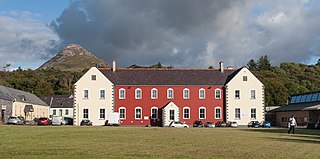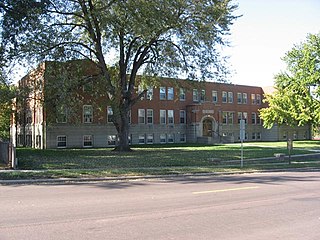
Cavan is the county town of County Cavan in Ireland. The town lies in Ulster, near the border with County Fermanagh in Northern Ireland. The town is bypassed by the main N3 road that links Dublin with Enniskillen, Ballyshannon and Donegal Town.

Virginia is a town in County Cavan, Ireland. Founded in the 17th century as a plantation town, it now holds both local industry and commuter housing.

Carrigallen is a small village in County Leitrim, Ireland. It is on the R201 and R203 roads in the east of the county, 19 km west of Cavan town. As of 2016, the village had a population of 387. The village is in a civil parish of the same name.
Events from the year 1943 in Ireland.

Swanlinbar is a small village on the N87 national secondary road in north-west County Cavan, Ireland, close to the Cladagh river and near the Fermanagh border.

The Company of the Daughters of Charity of Saint Vincent de Paul, commonly called the Daughters of Charity or Sisters of Charity of Saint Vincent De Paul, is a Society of Apostolic Life for women within the Catholic Church. Its members make annual vows throughout their life, which leaves them always free to leave, without the need of ecclesiastical permission. They were founded in 1633 by Vincent de Paul and state that they are devoted to serving the poor through the corporal and spiritual works of mercy.

Belturbet is a town in County Cavan, Ireland. It lies on the N3 road, around 14 km (8.7 mi) north of Cavan town and 123 km (76 mi) from Dublin. It is also located around 4 km (2.5 mi) south of the border with County Fermanagh, part of Northern Ireland, and is 36 km (22 mi) from Enniskillen.

Annibale Maria di Francia, RCJ was an Italian Catholic priest known for founding a series of orphanages, the Rogationist Fathers and the Daughters of Divine Zeal. He has been canonized as a saint and his feast day is 1 June.
The Congregation of the Sisters of Charity of the Incarnate Word is the name of two Roman Catholic religious institutes based in the U.S. state of Texas. They use the abbreviation C.C.V.I..

The Congregation of Our Lady of Charity of the Good Shepherd, also known as the Sisters of the Good Shepherd, is a Catholic religious order that was founded in 1835 by Mary Euphrasia Pelletier in Angers, France. The religious sisters belong to a Catholic international congregation of religious women dedicated to promoting the welfare of women and girls.
Kevin Coen was a volunteer in the Sligo Brigade of the Provisional Irish Republican Army (IRA) who was killed in County Fermanagh, Northern Ireland, by the British Army.
The Central Hotel fire, was a fire at a popular family-owned hotel in the heart of the seaside resort of Bundoran, County Donegal, in the northwest of Ireland. On 8 August 1980, a fire broke out killing ten people, including both locals and holiday makers. The tragedy was covered as part of the RTÉ television series Disasters in summer 2007.

Industrial schools were established in Ireland under the Industrial Schools (Ireland) Act 1868 to care for "neglected, orphaned and abandoned children". By 1884, there were 5,049 children in such institutions throughout the country. The Act was superseded by the Children Act 1908.

St. John's Orphanage, sometimes referred to as the Goulburn Boys Orphanage, was an orphanage located on Mundy Street in Goulburn, a town located in New South Wales, Australia. The architect of the building was EC Manfred. The foundation stone was laid and blessed on 17 March 1912 by Bishop John Gallagher of Goulburn, who also blessed the building during its opening ceremony in late 1913. It was two storeys high, and several extensions were added to the building throughout its early history. The orphanage amalgamated with St. Joseph's Orphanage for girls in 1976, and the remaining orphans were placed into group homes. As a result, the orphanage was closed in 1978 and rented out to the Youth with a Mission Base until they left in 1994. Since then, the orphanage remained abandoned, until its demolition in 2023.

The Monastery of The Holy Spirit, known locally as Kirk Edge Convent is a Carmelite monastery for nuns. It is situated on Kirk Edge Road between the villages of Worrall and High Bradfield within the boundaries of the City of Sheffield, England. It is one of 18 carmels in the United Kingdom. The building stands just within the Peak District at a height of 340 metres and has extensive views of the surrounding area.
Westbank Orphanage was a privately run Protestant orphanage in Greystones, County Wicklow, Ireland, which closed in the 1990s. Westbank was originally founded as the Protestant Home for Orphan & Destitute Girls. It moved from Harold's Cross in Dublin to Wicklow in the late 1940s, and began to accept boys as well as girls. The regime at the orphanage was Protestant evangelical Christian and was run by Miss Adeline Mathers, a born-again Christian. While it attempted to find homes for some children with Protestant families, many were retained as helpers and as a means of raising funds. Some children were sent illegally to families in Northern Ireland, England, and Scotland. The orphanage became controversial when allegations of abuses surfaced. In the 1960s children from another related and equally controversial Protestant home, the Bethany Home, were transferred to Westbank. The orphanage was designated by the Church of Ireland and the state as place to send Protestant orphans. Westbank children were sent to worship in Bray Gospel Hall. The orphanage was run by the Westbank Greystones Protestant Orphanage Charity, associated with Bray Gospel Hall. It was registered as a charity and availed of tax benefits as a result.

Kirwan House or The Female Orphan House was a Church of Ireland-run female orphanage initially at 42 Prussia Street (1790-93), next on Dublin's North Circular Road (1793-1959) and latterly at 134 Sandford Road in Ranelagh (1959-87).
St. Thomas–St. Vincent Orphanage was an orphanage located in Anchorage, Kentucky, best known for allegations of child sexual and physical abuse by one priest, seven nuns, and five laymen, between the 1930s and 1970s. It opened with the merger of St. Thomas Orphanage and St. Vincent Orphanage in 1955 and closed in 1983 as a result of rising costs and increased government services for orphans.
The Belturbet bombing occurred on 28 December 1972 when a car bomb planted by Loyalist paramilitaries exploded in the main street in the border town of Belturbet in County Cavan in the Republic of Ireland. The bomb killed two teenagers Geraldine O'Reilly (15) and Patrick Stanley (16). Nobody claimed responsibility for the bombing but security services believe the Ulster Volunteer Force (UVF) carried out the attack. The attack happened just a few weeks after two people were killed and 127 injured when two car bombs exploded in the centre of Dublin, Republic of Ireland on 1 December 1972. On the same day as the Belturbet bombing, two other bombs exploded in border counties, the first in Clones, County Monaghan which injured two people and the second in Pettigo in County Donegal which caused injury to a single female victim. The three bombs all exploded within 49 minutes of each other, all three bombings were believed to be part of a co-ordinated attack attributed to a single organization.

The Presentation Children's Home is a historic building at 701 South Western Avenue in Sioux Falls, South Dakota. Built to replace an earlier orphanage in Turton that burned down, it functioned not only as an orphanage—one of the few in South Dakota—but also as a school from its opening in 1940 to its closure in 1966. It was added to the National Register of Historic Places in 1993.














